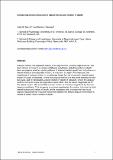Comparing motion induction in lateral motion and motion in depth
Abstract
Induced motion, the apparent motion of an object when a nearby object moves, has been shown to occur in a variety of different conditions, including motion in depth. Here we explore whether similar patterns of induced motion result from induction in a lateral direction (frontoparallel motion) or induction in depth. We measured the magnitude of induced motion in a stationary target for: (a) binocularly viewed lateral motion of a pair of inducers, where the angular motion is in the same direction for the two eyes, and (b) binocularly viewed motion in depth of inducers, where the angular motions in the two eyes are opposite to each other, but the same magnitude as for the lateral motion. We found that induced motion is of similar magnitude for the two viewing conditions. This suggests a common mechanism for motion induction by both lateral motion and motion in depth, and is consistent with the idea that the visual signals responsible for induced motion are established before angular information is scaled to obtain metric motion in depth.
Citation
Harris , J & German , KJ 2008 , ' Comparing motion induction in lateral motion and motion in depth ' , Vision Research , vol. 48 , no. 5 , pp. 695-702 . https://doi.org/10.1016/j.visres.2007.11.018
Publication
Vision Research
Status
Peer reviewed
ISSN
0042-6989Type
Journal article
Collections
Items in the St Andrews Research Repository are protected by copyright, with all rights reserved, unless otherwise indicated.
Related items
Showing items related by title, author, creator and subject.
-
The visual processing of speed in two and three dimensions
Lee, Abigail Rachael Ingle (University of St Andrews, 2020-06-26) - ThesisAs animals that move in a 3D world and interact with 3D objects, it is very important for our survival that our visual systems provide two- and three-dimensional motion perception. Over 4 experimental chapters, we used ... -
Factors affecting the financial success of motion pictures : what is the role of star power?
Selvaretnam, Geethanjali; Yang, Jen-Yuan (University of St Andrews, 2015-01-12) - Working or discussion paperIn the mid-1940s, American film industry was on its way up to its golden era as studios started mass-producing iconic feature films. The escalating increase in popularity of Hollywood stars was actively suggested for its ... -
Temporal estimation in prediction motion tasks is biased by a moving destination
Flavell, Jonathan C.; Barrett, Brendan T.; Buckley, John G.; Harris, Julie M.; Scally, Andrew J.; Beebe, Nathan B.; Cruickshank, Alice G.; Bennett, Simon J. (2018-02-14) - Journal articleAn ability to predict the time-to-contact (TTC) of moving objects that become momentarily hidden is advantageous in everyday life and could be particularly so in fast-ball sports. Prediction motion (PM) experiments have ...

